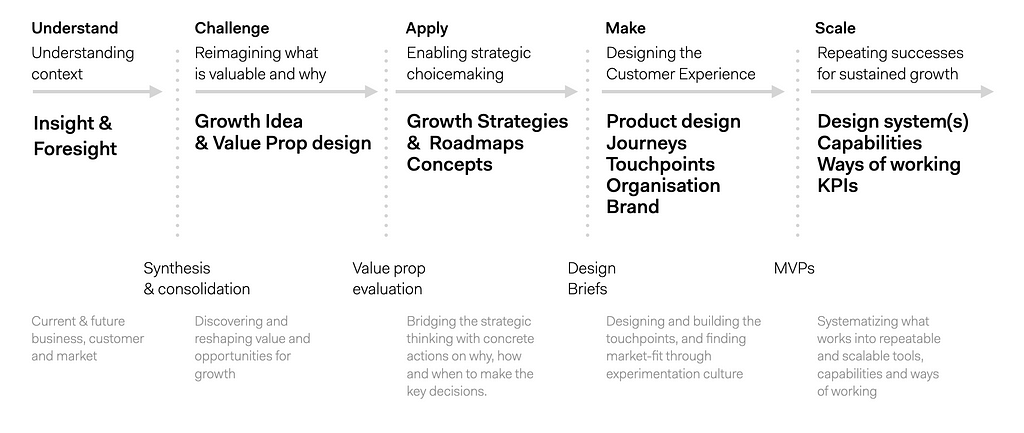Juhani Haaparanta
Managing Director

Managing Director
Nordkapp is a strategic design agency that redefines and creates value for your current and future business through design. What, exactly, do we mean when we talk about value and design?
Throughout the decades of design as a profession, these question about the role and meaning of design has surfaced in countless discussions. And the answers have been multi-faceted as well —differing greatly from industrial design to graphic design and from human-computer interaction to business model innovation, design thinking and beyond.
There’s probably no other discipline which contains so many separate competences inside it. During my whole career I’ve had colleagues come from many different backgrounds: From schools of arts, media, business, technology, philosophy, education or ethnography, to name just a few. And all have been great designers.
The sheer amount of multiple, diverse voices within the community makes the concept of design quite hard to grasp already on linguistic level. For example, in Finnish we have two different words for design: muotoilu (originates from Swedish word ‘formgivare‘; giving form to something) and suunnittelu (making plans on something) are both equally used but semantically totally different words about same discipline: design.
The strength and soul of design, however, is the same, no matter the discipline or the background: Design in its core is about searching and creating something new and unseen. I’ve had numerous discussions where designers have been compared to explorers or renaissance artists: the search for the unknown is what makes us tick and enjoy our work — day in, day out.
However, even though the interpretation of design is various and wide, the industry sees design in a much more focused way than designers do. Depending on the company, design is treated as a part of IT development, a part of marketing, or a part of R&D operations. Very rarely is design seen as an overarching, horizontal discipline that affects all strategies and broad ways of working.
We at Nordkapp believe this needs to change: design is the holistic glue that unveils and helps to uncover value from internal strategies, processes, ways of working and above all — people.
Design thinking and the recent rise of service design have already begun to affect companies at a broader level than just product design. The McKinsey Design index gives companies quantitative proof that design actually has a monetary value with higher returns to shareholders. These are already good examples which demonstrate the wider meaning of design than just “beautifying” layouts.
In the industry, many things still remain uncompleted in order to really change the perception of design, to transform it from a strategic competence to an overarching principle.
For us, design is a way of seeing and shaping positive impact throughout the value chain, bridging the abstract to tangible.
As said, we see the purpose of design within searching and creating the unseen — and obviously the unseen will need to create a measurable impact and an advantage compared to earlier solutions.
The redefinition and creation of value is what we strive for. Thinking holistically throughout the value chains and through the means of design, uncovering the opportunities and creating tangible solutions is our end goal.
In order to understand this better — let’s look at a generic value chain and how we think of it: From the context understanding to systematic scaling, design methodologies and practices have their place:

Understanding context: By gathering information and insight about the present and envisioning possible futures through foresight we are able to better understand the unmet needs, hidden motivations and recognize opportunities that can add value.
Challenging: Through the understanding of existing capabilities and tomorrow’s opportunities, we will reimagine the value proposition and understand what future solutions are desirable, feasible and viable.
Applying: The ability to make a concrete, tangible concept and understanding the realistic efforts to build the concepts is a key competence to drive a successful solution creation process. In this phase we usually build examples, mockups and roadmaps that help us to understand the path and plan for growth.
Making: This is what we as an agency are well-known for: creating the actual solutions that can be tested with real customers with uncompromised quality. Nothing compares to the excitement just before releasing the first versions of products and services for the customers. With a good product there’s usually nothing to worry about at this point.
Scaling: Products and Services are never ready — they need to constantly evolve and the iterations needs to be systematic and well planned in order to stay ahead of the curve and reach the full potential of solutions. In addition of the products this concerns also we as designers and persons — our ways of working, our learning and our capabilities need to evolve.
In reality, value chains are not processes or linear structures even though in most cases those are pictured as a process — everything happens simultaneously.
Very seldomly are these processes linear. In practice, most processes happen in parallel to some extent. Design methodology is not meant to be drive value chains from A-Z in a linear order but rather offer methodologies that enable structure and confidence in complex environments. A corporate value chain is constant flux, but through the means and methods of design we are able make the abstract changes tangible and manageable.
The year of 2020 has so far been full of surprises. The sudden rise of Covid-19 and the shock it caused on a global level to individuals, families, cities, governments and to all of humanity has been unprecedented.
Many companies took notice that normal procedures don’t work in abnormal times and started to examine new ways of creating value in order to survive in the first place. These actions will have surprising long-term effects on our society — suddenly home deliveries became the de facto way of buying groceries, remote working is suddenly the preferred way of working. The speed of adapting innovation has sped up dramatically — many things viewed as a gimmick just a few months ago have suddenly become the baseline for building what’s next.
During volatile times it’s necessary and expected to challenge the norms, but I dare to say that the same spirit is even more crucial when these volatile times have passed. If you need help, discussion partner or sparring in getting things done and creating the unseen advantage for your purpose, you know where to find us!
Reimagining value is what the future is all about.
Reimagining Value and the Role of Design was originally published in Future is Present Tense on Medium, where people are continuing the conversation by highlighting and responding to this story.